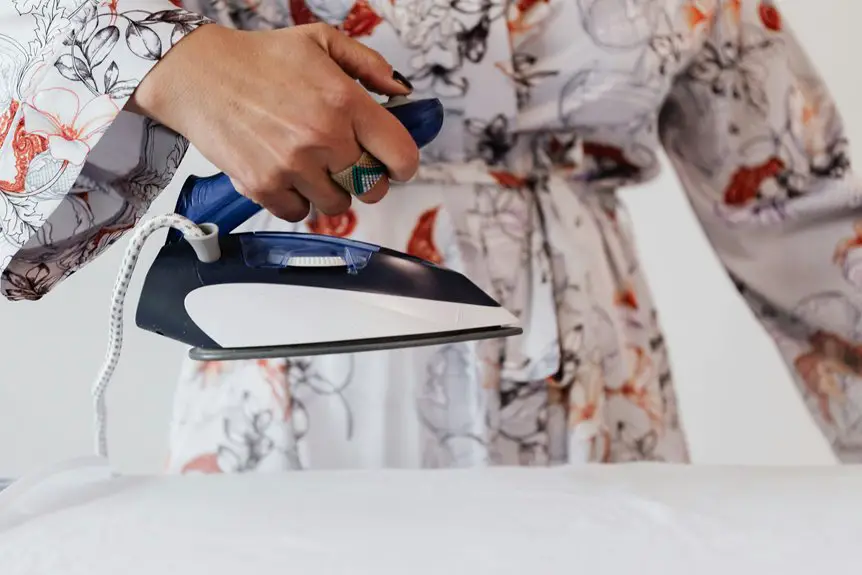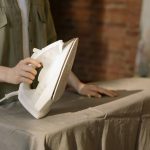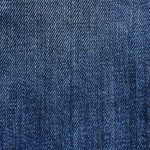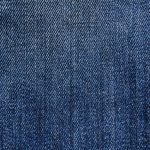You can steam scuba fabric, but you need to be careful. Since it’s made from polyester and spandex, the heat and moisture from steam can relax wrinkles but might also weaken fibers or distort the shape if overdone. Keep the steamer a few inches away, use short bursts, and test on a hidden spot first. Let the fabric dry flat before wearing. If you want to handle your scuba garments properly and avoid damage, there’s more to learn about safe steaming and care.
Table of Contents
Key Takeaways
- Scuba fabric can be steamed carefully from a few inches away to relax wrinkles without direct nozzle contact.
- Use short bursts of steam and test a hidden area first to avoid heat or moisture damage.
- Keep the fabric slightly stretched and move the steamer slowly to maintain shape and texture.
- Avoid ironing scuba fabric, as direct heat can cause permanent damage.
- Allow the fabric to air dry and cool completely after steaming before handling or storing.
What Is Scuba Fabric Made Of?
Scuba fabric is a type of double-knit material made primarily from a blend of polyester and spandex. When you wear or handle scuba fabric, you’ll notice its smooth texture and slight stretch.
The polyester provides durability and resistance to wrinkles and shrinking, while the spandex adds flexibility and shape retention. This combination gives scuba fabric its signature thickness and structured feel without being heavy.
Unlike traditional neoprene used in diving suits, scuba fabric is lighter and more breathable, making it popular for fashion garments. You’ll find it in dresses, skirts, and activewear because it holds its shape well and feels comfortable against the skin.
Understanding this blend helps you appreciate why scuba fabric behaves uniquely compared to other textiles.
How Does Steaming Work on Fabrics?
Knowing what scuba fabric is made of helps explain how it reacts to different care methods, including steaming. When you steam fabric, you’re applying hot, moist air to relax its fibers, smoothing out wrinkles without direct contact.
Understanding scuba fabric’s makeup reveals how steaming gently relaxes its fibers to remove wrinkles.
The heat and moisture penetrate the material, loosening tight fibers and allowing them to reshape. This method works well on many synthetic and natural fabrics because it’s gentle and doesn’t risk burning or crushing the texture like ironing might.
However, the effectiveness depends on the fabric’s composition and thickness. Since scuba fabric is thick and has a closed-cell structure, steaming affects it differently compared to lightweight materials.
Understanding this helps you decide whether steaming is suitable and how to approach it carefully for scuba fabric.
Risks of Steaming Scuba Fabric
You need to be careful when steaming scuba fabric because its integrity can weaken under high heat.
The material is sensitive, and too much steam might cause texture damage or warping.
Understanding these risks helps you avoid ruining your garment.
Fabric Integrity Concerns
Although steaming can refresh many fabrics, it poses specific risks to scuba fabric’s structure. You should know that the tightly woven fibers and foam core in scuba fabric can weaken or deform under moisture and pressure. This can lead to loss of elasticity and shape over time, reducing the garment’s durability and fit.
Here’s a quick overview:
| Concern | Cause | Effect |
|---|---|---|
| Fiber weakening | Moisture + steam pressure | Loss of fabric strength |
| Foam degradation | Prolonged steam exposure | Reduced cushioning and support |
| Shape distortion | Heat and moisture combo | Garment loses original fit |
When you steam scuba fabric, you risk compromising its integrity, so proceed with caution or explore gentler cleaning alternatives.
Heat Sensitivity Issues
Because scuba fabric contains heat-sensitive materials, applying steam can quickly damage its fibers and foam core.
When you expose scuba fabric to high temperatures, the heat may weaken or melt the synthetic fibers, compromising the fabric’s strength and flexibility.
The foam core, essential for its thickness and structure, can also warp or deteriorate, leading to permanent deformation.
You might notice shrinking, warping, or stiffness after steaming, which ruins the fabric’s intended smoothness and resilience.
Since scuba fabric isn’t designed to handle intense heat, even brief exposure to steam can cause irreversible damage.
To preserve its quality, you should avoid steaming and opt for gentler cleaning methods that don’t involve heat, ensuring your scuba fabric maintains its durability and appearance over time.
Potential Texture Damage
The heat sensitivity of scuba fabric doesn’t just risk structural damage—it can also harm its texture in ways that are hard to fix.
When you steam scuba fabric, you might notice changes like stiffening or uneven surfaces. These texture issues happen because the fabric’s foam core can react unpredictably to heat and moisture.
To avoid problems, watch out for:
- Loss of fabric’s smooth, sleek finish
- Formation of hard, crispy spots
- Uneven puffiness or flat areas
- Surface sheen becoming dull or patchy
- Fabric feeling rough or less flexible
If you want to keep your scuba fabric looking and feeling right, it’s better to avoid steaming or test on a small hidden section first.
Proper Techniques for Steaming Scuba Fabric
When you steam scuba fabric, you’ll want to take care to avoid direct contact with the steamer’s nozzle, as excessive heat can damage the material.
Hold the steamer a few inches away to allow the steam to gently relax the fibers without saturating or overheating them. Move the steamer slowly and evenly over the fabric, focusing on wrinkles without pressing down.
Hold the steamer a few inches away, moving slowly to gently relax fibers without overheating or saturating the fabric.
It’s best to keep the fabric stretched slightly on a flat surface or mannequin to prevent unwanted creases. Avoid over-steaming one area to reduce the risk of texture distortion.
After steaming, let the fabric air dry completely before handling or wearing it. These techniques will help you refresh scuba fabric safely while maintaining its smooth, structured appearance.
Recommended Steamer Settings for Scuba Material
Keeping your steamer at the right settings plays a key role in protecting scuba fabric from damage while effectively removing wrinkles.
You want to balance heat and moisture carefully since scuba is a thick, synthetic material that can warp or stretch under too much heat.
Here are the recommended steamer settings for scuba fabric:
- Use a low to medium steam setting to prevent overheating.
- Avoid using the highest heat setting; it can melt the fabric.
- Hold the steamer about 6-8 inches away to avoid direct contact.
- Steam in short bursts rather than continuous flow to control moisture.
- Always test on a small, hidden area first to guarantee fabric safety.
Following these settings helps keep your scuba fabric smooth without compromising its texture or shape.
Alternatives to Steaming for Removing Wrinkles
Although steaming is effective, you might want alternatives to remove wrinkles from scuba fabric without risking heat damage.
One option is to hang the garment in a steamy bathroom; the natural moisture helps relax wrinkles gently. You can also try laying the fabric flat and smoothing out wrinkles with your hands.
If you prefer, place a damp cloth over the fabric and press lightly with your hands to ease creases. Avoid ironing since direct heat can ruin scuba material.
Another trick is to store the garment properly—hanging it instead of folding prevents deep wrinkles.
These methods protect your fabric’s texture and shape while keeping it wrinkle-free without exposing it to potentially harmful heat.
How to Test Steaming on Scuba Fabric Safely
Since scuba fabric can be sensitive to heat, you should always test steaming on a small, hidden area first. This helps prevent damage to the entire garment.
To test safely, follow these steps:
- Choose an inconspicuous spot like the inside seam or hem.
- Set your steamer to a low heat setting.
- Hold the steamer about 6 inches away from the fabric.
- Steam briefly, for just 1-2 seconds.
- Let the area cool and inspect for any changes in texture or color.
If you notice any distortion, shrinkage, or discoloration, avoid steaming the whole piece.
Testing first guarantees you can confidently use steam without risking irreversible harm to your scuba fabric.
Caring for Scuba Fabric After Steaming
After steaming your scuba fabric, make sure you let it cool down properly to prevent any damage.
Handle the fabric gently to avoid stretching or warping its shape.
Finally, store your scuba garments in a way that keeps them wrinkle-free and maintains their quality.
Cooling Down Properly
When you finish steaming your scuba fabric, let it cool completely before handling or storing it. This prevents any distortion or marks caused by premature contact.
To cool your fabric properly:
- Lay it flat on a clean, dry surface away from direct sunlight.
- Avoid folding or bunching the fabric until it’s fully cooled.
- Keep it in a well-ventilated area to speed up cooling.
- Don’t place heavy objects on top during cooling to maintain shape.
- Resist the urge to touch or stretch the fabric while it’s warm.
Following these steps helps maintain the fabric’s smooth texture and shape, ensuring your scuba fabric looks its best after steaming.
Cooling properly is key to lasting results.
Avoiding Fabric Damage
Proper care is essential to avoid damaging your scuba fabric once it’s steamed.
After steaming, let the fabric cool completely before handling it to prevent stretching. Avoid applying excessive pressure or pulling, as the material can lose its shape. Keep the fabric away from sharp objects or rough surfaces to prevent snags or tears.
If you notice any moisture, gently pat it dry with a clean cloth instead of rubbing. Always steam in short bursts rather than prolonged exposure, which can weaken the fibers.
Finally, avoid using harsh chemicals or abrasive cleaners on steamed areas. By following these steps, you’ll maintain your scuba fabric’s texture and durability, ensuring it stays looking fresh and lasts longer.
Storing Scuba Garments
Once you’ve carefully steamed your scuba fabric and allowed it to cool, storing your garment correctly will help preserve its shape and texture.
You want to avoid creases and stretching that could ruin the smooth finish you worked hard to achieve. Here’s how to store your steamed scuba garments properly:
- Hang on a wide, padded hanger to maintain shape
- Keep in a cool, dry place away from direct sunlight
- Avoid overcrowding in your closet to prevent wrinkles
- Use breathable garment bags for extra protection
- Fold carefully only if hanging space is unavailable, placing tissue paper between folds
Common Mistakes to Avoid When Steaming Scuba
Although steaming scuba fabric can refresh its appearance, you’ll want to steer clear of common mistakes that can damage the material.
First, avoid applying the steamer too close; excessive heat and moisture can warp the fabric’s texture. Hold the steamer at least a few inches away to prevent this.
Keep the steamer several inches away to avoid warping the scuba fabric’s texture with heat and moisture.
Don’t press the steamer directly onto the fabric, as this can leave water spots or cause pilling. Also, never steam over embellishments or seams, since the heat might weaken glue or stitching.
Skipping a patch test on a hidden area is another misstep—you need to verify the fabric reacts well to steam.
Finally, don’t steam for too long; prolonged exposure can stretch or deform the fabric’s shape.
Follow these tips to keep your scuba garments looking great.
When to Seek Professional Cleaning for Scuba Garments
If you notice stubborn stains that won’t budge or have delicate embellishments on your scuba fabric, it’s best to call in the pros.
Persistent odors that don’t fade with regular care also signal it’s time for professional cleaning. Knowing when to seek expert help will keep your scuba garments looking their best.
Identifying Stubborn Stains
How can you tell when a stain on your scuba fabric needs professional attention? You’ll want to act quickly if the stain resists your usual cleaning methods. Stubborn stains often require expert care to avoid damage.
Look out for these signs:
- Stain remains after gentle steaming or spot cleaning
- Discoloration spreads beyond the stain area
- Fabric texture feels stiff or altered at the stain site
- Stain appears oily, ink-based, or deeply set
- Multiple stains or large affected areas
If you notice any of these, it’s best to consult a professional cleaner experienced with scuba fabric. They’ve specialized techniques and products to safely remove tough stains without harming the material.
Don’t risk ruining your garment by tackling these stains alone.
Delicate or Embellished Pieces
When you encounter stains that challenge your cleaning skills, it’s a good reminder that some scuba garments need extra care beyond stain removal. Delicate or embellished pieces, like those with beads or sequins, can easily get damaged by home steaming. You should consider professional cleaning to protect their integrity. Professionals use specialized techniques that guarantee your garment stays intact and looks its best.
| Garment Type | Risk with Home Steaming | Recommended Action |
|---|---|---|
| Beaded Scuba Dress | High damage risk | Professional cleaning |
| Embellished Jacket | Fabric distortion | Avoid home steaming |
| Plain Scuba Top | Low risk | Safe to steam at home |
Knowing when to seek expert help saves your favorite pieces from irreversible damage.
Handling Persistent Odors
Although scuba fabric repels water and stains, persistent odors can still cling stubbornly to your garments. When home steaming or washing doesn’t fully remove these smells, it’s time to contemplate professional cleaning.
Professionals use specialized treatments that penetrate deep without damaging the fabric’s structure or finish.
You should seek professional help if:
- Odors linger despite thorough airing and steaming
- Fabric shows signs of discoloration or damage after cleaning attempts
- Your garment has delicate or intricate details
- You’re uncertain about the best cleaning method
- The item holds significant sentimental or monetary value
Frequently Asked Questions
Can Scuba Fabric Be Machine Washed Without Damage?
You shouldn’t machine wash scuba fabric because it can damage the material’s stretch and texture. Instead, hand wash it gently in cold water with mild detergent to keep it looking fresh and maintain its shape.
What Is the Best Way to Store Scuba Fabric Garments?
You should hang scuba fabric garments on padded hangers to maintain shape, avoid creases, and keep them in a cool, dry place away from direct sunlight. Folding can cause permanent wrinkles, so hanging’s best.
Does Scuba Fabric Shrink After Washing?
You won’t see much shrinkage with scuba fabric after washing because it’s made from synthetic fibers. Just make sure to wash it in cold water and avoid high heat drying to keep its shape intact.
Can Scuba Fabric Be Dyed at Home?
If you’re feeling adventurous, you can gently dye scuba fabric at home, but remember it’s a bit picky. Use fabric-specific dyes, follow instructions closely, and test a small piece first to avoid any surprises.
How Long Does Scuba Fabric Typically Last With Regular Use?
You can expect scuba fabric to last around 3 to 5 years with regular use. Its durability depends on care, washing frequency, and exposure to harsh conditions, so treating it gently will help extend its lifespan.







